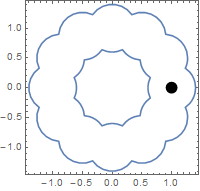animation - How to simulate the true reflective movement of a particle bouncing around in an ellipse?
Please help me to simulate the movement of a particle inside a region with elliptical walls such that particle is reflected from the walls and continues to move.
A friend was able write code to simulate a particle represented by a Disk bouncing around inside a square, but we can't do it for an ellipse.
x = 0.5;
y = 0.5;
vx = 1;
vy = Pi/2;
step = 0.01;
radius = 0.05;
Animate[
x = x + vx*step;
y = y + vy*step;
If[Abs[x - 1] <= radius || Abs[x] <= radius , vx = -vx];
If[Abs[y - 1] <= radius || Abs[y] <= radius, vy = -vy];
Graphics[{
Cyan, Rectangle[{0, 0}, {1, 1}],
Gray, Disk[{x, y}, radius],
Point[{0.0, 0.0}], Point[{1.0, 1.0}]
}],
{t, 0, Infinity}
]
Answer
Edit V10!
This is simple example what we can now do in real time!
R = RegionUnion @@ Table[Disk[{Cos[i], Sin[i]}, .4], {i, 0, 2 Pi, Pi/6.}];
R2 = RegionBoundary@DiscretizeRegion@R;
go[] := (While[r > .105, x += v; r = RegionDistance[R2, x]; Pause[.01]]; bounce[];)
bounce[] := With[{normal = Normalize[x - RegionNearest[R2, x]]},
If[break, Abort[]];
v = .01 Normalize[v - 2 v.normal normal];
x = x + v;
r = RegionDistance[R2, x]; go[]
]
x = {1, 0.};
pos = {x};
break = False;
v = .01 Normalize@{2, 1.};
r = RegionDistance[R2, x];
RegionPlot[R2, Epilog -> Dynamic@Disk[x, .1], AspectRatio -> Automatic]
Button["break at edge", break = True;]
go[]

This is an example, not perfect but nice enough to start.
V9
Unfortunately I don't have time to explain now. But take a look at wikipedia ellips site, tangent line part especially.
DynamicModule[{u = 0, t0, imp, v1, x0 = {0, .49}, v0 = {.5, -1.0}, t, a = 1, b = .5,
c, f1, f2},
DynamicWrapper[
Graphics[{ Thick, Scale[Circle[], {a, b}], AbsolutePointSize@7, Dynamic@Point[x0],
Dashed, Thin, Dynamic@Line[{{x0, imp}, {imp, imp + Normalize@v1},
{imp - normal, imp + normal}}]
}, PlotRange -> 1.1, ImageSize -> 500, Frame -> True],
Refresh[
If[(#/a)^2 + (#2/b)^2 & @@ x0 < 1,
x0 += v0;,
x0 = imp + v1; v0 = v1; rec]
, TrackedSymbols :> {}, UpdateInterval -> .001]]
,
Initialization :> (
c = Sqrt[a^2 - b^2]; v0 = Normalize[v0]/100; f1 = {-c, 0}; f2 = {c, 0};
rec := ({t0, imp} = {t, x0 + t v0
} /. Quiet@NSolve[(#/a)^2 + (#2/b)^2 & @@ (x0 + t v0) == 1. &&
t > 0, t, Reals][[1]];
normal = Normalize[Normalize[imp - f1] + Normalize[imp - f2]];
v1 = Normalize[v0 - 2 normal (v0.normal)]/100;(*bounce*));
rec)]

Comments
Post a Comment